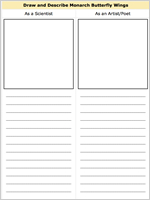Background: Authors make pictures with words. Sentences that include sensory details
that help a reader visualize ideas are called Snapshot Sentences.
Reading
Strategies: Identify Main Ideas and Details, Visualize
Ideas from Text, Synthesize Ideas, Summarize Information,
Make Inferences and Draw Conclusions |
|
Procedures:
1. Observe and Describe:
When students are out in the field, challenge them to observe closely with all their senses. Have them sketch and write about specific details they see, hear, smell, and feel. Create snapshot sentences using details collected from observations.
Take students outdoors for a “Snapshot Sit.” Have students
bring a notebook and pencil outside to collect sensory details: What do
you see? What do you hear? How does the air feel? What smells does your
nose detect? Using the details they collect, students write snapshot sentences,
paragraphs, or poems that describe their field observations.
2. Collect Snapshot Sentences:
After reading an informational selection that contains snapshot sentences, have students underline descriptive words and phrases.
Discuss how the author was able to evoke strong images by using sensory details and figurative language, such
as similes and metaphors.
Samples and Helpful Handouts:
1. Look closely at monarch butterfly wings.
Display images from the monarch butterfly wings photo gallery. Distribute copies of the pre-writing attribute chart. Have students work with a partner to brainstorm sensory details to describe colors, shapes, sizes, textures, patterns, and distinctive features/markings.
Have students explore how they can use words on their pre-writing attribute charts to write snapshot sentences that describe monarch wings.
2. Draw and describe monarch wings.
Use the draw and describe handout to help students explore the science and art of monarch butterfly wings:
- As a scientist:
Challenge students to create a scientific illustration and written description of monarch wings. Remind students that a scientist's work is objective. A scientist would represent and describe the characteristics and features—patterns, size, textures, and colors—of the wings as accurately as possible.
- As an artist/poet:
The goal of expressive drawing and writing is to capture the thoughts and feelings that are inspired by observations of nature. An artist's work is subjective. Challenge students to think about how an artist and poet would draw and describe a monarch butterfly to express the beauty and wonder of its wings. Spark creativity by encouraging students to capture how they feel when they observe monarchs.
Variations:
1. Invite students to write snapshot sentences and paragraphs using descriptive
details/language collected from reading a variety of selections on a topic.
2. Invite students to add/insert snapshot sentences into expository texts
to include ideas that help readers visualize details.
|
Sample Activity

Photo Gallery
Monarch Wings

Attribute Chart

Draw and Describe
Monarch Wings
|





